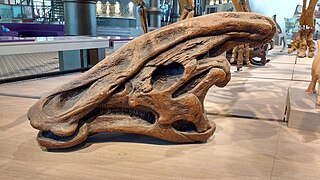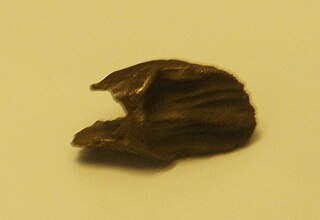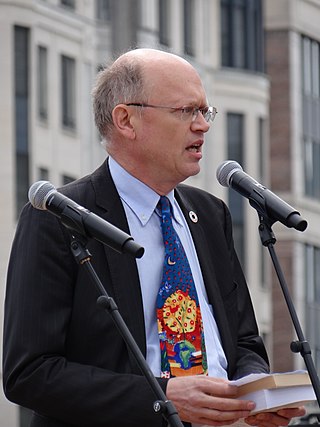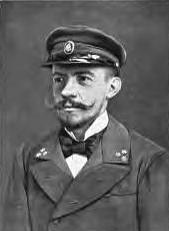Related Research Articles
Lepagia is an extinct genus of poorly known carnivorous cynodonts, which lived during the Upper Triassic in Europe. Partly due to the paucity of remains the precise affinities of this genus are unclear. It seems reasonably closely related to Probainognathus, a somewhat earlier inhabitant of South America. The genus Lepagia was named by Hahn, Wild and Wouters in 1987 based on a single species.

Jean Bricmont is a Belgian theoretical physicist and philosopher of science. Professor at the Catholic University of Louvain (UCLouvain), he works on renormalization group and nonlinear differential equations. Since 2004, He is a member of the Division of Sciences of the Royal Academy of Belgium.

The Museum of Natural Sciences of Belgium is a museum dedicated to natural history, located in Brussels, Belgium. The museum is a part of the Royal Belgian Institute of Natural Sciences. Its most important pieces are 30 fossilised Iguanodon skeletons, which were discovered in 1878 in Bernissart, Belgium.

The Royal Museum for Central Africa or RMCA, also officially known as the AfricaMuseum, is an ethnography and natural history museum situated in Tervuren in Flemish Brabant, Belgium, just outside Brussels. It was built to showcase King Leopold II's Congo Free State in the International Exposition of 1897.

Baron Michel Edmond de Selys Longchamps was a Belgian Liberal Party politician and scientist. Selys Longchamps has been regarded as the founding figure of odonatology, the study of the dragonflies and damselflies. His wealth and influence enabled him to amass one of the finest collections of neuropteroid insects and to describe many species from around the world. His collection is housed in the Royal Belgian Institute of Natural Sciences.

Olorotitan was a genus of lambeosaurine duckbilled dinosaur from the middle or latest Maastrichtian-age Late Cretaceous, whose remains were found in the Udurchukan Formation beds of Kundur, Amur River Region, Far Eastern Russia. The type, and only species is Olorotitan arharensis. It was one of the last non-avian dinosaurs and it went extinct during the Cretaceous–Paleogene extinction event.

Charonosaurus is a genus of dinosaur whose fossils were discovered by Godefroit, Zan & Jin in 2000 on the south bank of the Amur River, dividing China from Russia. It is monotypic, consisting of the species C. jiayinensis.

Craspedodon is an extinct genus of ornithischian dinosaur, possibly a ceratopsian. It lived during the Late Cretaceous, in what is now Belgium. Only a few teeth have ever been found, which were described as similar to those of Iguanodon. Craspedodon lonzeensis, described by Louis Dollo in 1883, is the type species, although it is considered a nomen dubium since it is based on fragmentary material. It was long thought to be an iguanodontian, but a 2007 restudy suggested that it was actually a neoceratopsian, perhaps closer to Ceratopsoidea than Protoceratopsidae. If the reidentification is correct, Craspedodon would be the first neoceratopsian known from Europe.

Mantellisaurus is a genus of iguanodontian dinosaur that lived in the Barremian and early Aptian ages of the Early Cretaceous Period of Europe. Its remains are known from Belgium (Bernissart), England, Spain and Germany. The type and only species is M. atherfieldensis. Formerly known as Iguanodon atherfieldensis, the new genus Mantellisaurus was erected for the species by Gregory Paul in 2007. According to Paul, Mantellisaurus was more lightly built than Iguanodon and more closely related to Ouranosaurus, making Iguanodon in its traditional sense paraphyletic. It is known from many complete and almost complete skeletons. The genus name honours Gideon Mantell, the discoverer of Iguanodon.

Gembloux Agro-Bio Tech (GxABT), located in Gembloux, Belgium, is one of the eleven faculties of the University of Liège. Founded in 1860 and previously known as the Faculté universitaire des sciences agronomiques de Gembloux, it is Belgium's oldest educational and research institution dedicated to agronomic sciences and biological engineering. It is the only school in Belgium to be accredited by the French Commission des Titres d'Ingénieur allowing the university to deliver the Diplôme d'Ingénieur engineering degree. The school is also accredited by the EUR-ACE label, the highest European quality label for engineering degree programmes at Bachelor and Master level.
Argiles et Grès à Reptiles Formation also known as the Argiles Rutilantes Formation is an early Maastrichtian French geologic formation in the département of Var preserving the remains of several types of dinosaurs and other extinct organisms.

Wulagasaurus is a genus of saurolophine hadrosaurid dinosaur from the Late Cretaceous of Heilongjiang, China. Its remains were found in a bonebed in the middle Maastrichtian-age Yuliangze Formation, dated to 69 million years ago. This bonebed is otherwise dominated by fossils of the lambeosaurine hadrosaurid Sahaliyania. Wulagasaurus was named by Pascal Godefroit and colleagues in 2008. Only partial remains are known at this time. It is one of several hadrosaurids from the Amur River region named since 2000. The type and only species to date is W. dongi, named in honor of Chinese paleontologist Dong Zhiming. In 2010 Gregory S. Paul estimated its size at 9 meters and 3 tonnes.
The Royal Academy for Overseas Sciences or RAOS is a Belgian federal academy that contributes to the progress of scientific knowledge about overseas regions. It is located in Uccle, Brussels and is one of Belgium's numerous academies.

Jean-Pascal van Ypersele de Strihou is a Belgian academic climatologist. He is a professor of Environmental Sciences at the UCLouvain (Belgium). As a previous vice-chair of the IPCC, Van Yp is one of the forerunners of climate change mitigation through strong decrease of fossil fuel consumption.
Goniosaurus is an extinct genus of plesiosaur from the Late Cretaceous of the Nekum Chalk, in Netherlands. The only species so far described, G. binskhorsti is represented only by an isolated, compressed and slender tooth described by Hermman Meyer and a referred tooth and a cervical vertebra that shows that was an elasmosaurid, as many others Late Cretaceous plesiosaurs from Europe.
The Bayan Mandahu Formation is a geological unit of "redbeds" located near the village of Bayan Mandahu in Inner Mongolia, China Asia and dates from the late Cretaceous Period. Laid down in the Campanian, it is dated somewhat uncertainly to between 75 and 71 mya.

Georges Lecointe was a Belgian naval officer and scientist. He was captain of the Belgica and second-in-command of the Belgian Antarctic Expedition, the first to overwinter in Antarctica. After his return to Belgium he was the founder of the International Polar Organization and deeply involved in the foundation of the International Research Council and the International Astronomical Union.

Aurornis is an extinct genus of anchiornithid theropod dinosaurs from the Jurassic period of China. The genus Aurornis contains a single known species, Aurornis xui. Aurornis xui may be the most basal ("primitive") avialan dinosaur known to date, and it is one of the earliest avialans found to date. The fossil evidence for the animal pre-dates that of Archaeopteryx lithographica, often considered the earliest bird species, by about 10 million years.

Sisteronia is an extinct genus of platypterygiine ophthalmosaurid ichthyosaur known from the 'middle' Cretaceous of southeastern England and southeastern France. It contains a single species, Sisteronia seeleyi.
The Royal Academy of Science, Letters and Fine Arts of Belgium is the independent learned society of science and arts of the French Community of Belgium. One of Belgium's numerous academies, it is the French-speaking counterpart of the Royal Flemish Academy of Belgium for Science and the Arts. In 2001 both academies founded a joint association for the purpose of promoting science and arts on an international level: The Royal Academies for Science and the Arts of Belgium (RASAB). All three institutions are located in the same building, the Academy Palace in Brussels.
References
- ↑ Miserey, Yves (4 June 2013). "Un petit dinosaure chinois, nouvel ancêtre des oiseaux". Le Figaro (in French). Dassault Group . Retrieved 9 November 2013.
- ↑ "Muséum des Sciences Naturelles – Direction opérationnelle Terre et Histoire de la Vie" (in French). Royal Belgian Institute of Natural Sciences. Archived from the original on 12 August 2014. Retrieved 9 November 2013.